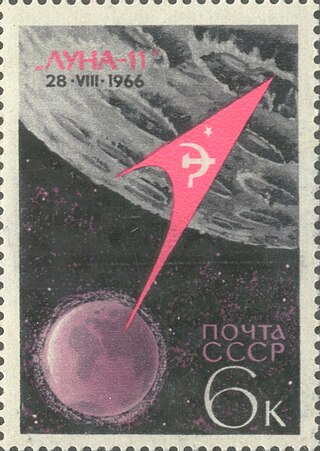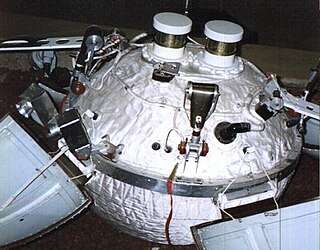
The Surveyor program was a NASA program that, from June 1966 through January 1968, sent seven robotic spacecraft to the surface of the Moon. Its primary goal was to demonstrate the feasibility of soft landings on the Moon. The Surveyor craft were the first American spacecraft to achieve soft landing on an extraterrestrial body. The missions called for the craft to travel directly to the Moon on an impact trajectory, a journey that lasted 63 to 65 hours, and ended with a deceleration of just over three minutes to a soft landing.

Surveyor 3 is the third lander of the American uncrewed Surveyor program sent to explore the surface of the Moon in 1967 and the second to successfully land. It was the first mission to carry a surface-soil sampling-scoop.

Surveyor 1 was the first lunar soft-lander in the uncrewed Surveyor program of the National Aeronautics and Space Administration. This lunar soft-lander gathered data about the lunar surface that would be needed for the crewed Apollo Moon landings that began in 1969. The successful soft landing of Surveyor 1 on the Ocean of Storms was the first by an American space probe on any extraterrestrial body, occurring on the first attempt and just four months after the first soft Moon landing by the Soviet Union's Luna 9 probe.

The Ranger program was a series of uncrewed space missions by the United States in the 1960s whose objective was to obtain the first close-up images of the surface of the Moon. The Ranger spacecraft were designed to take images of the lunar surface, transmitting those images to Earth until the spacecraft were destroyed upon impact. A series of mishaps, however, led to the failure of the first six flights. At one point, the program was called "shoot and hope". Congress launched an investigation into "problems of management" at NASA Headquarters and Jet Propulsion Laboratory. After two reorganizations of the agencies, Ranger 7 successfully returned images in July 1964, followed by two more successful missions.

The Luna programme, occasionally called Lunik by western media, was a series of robotic spacecraft missions sent to the Moon by the Soviet Union between 1959 and 1976. The programme accomplished many firsts in space exploration, including first flyby of the Moon, first impact of the Moon and first photos of the far side of the Moon. Each mission was designed as either an orbiter or lander. They also performed many experiments, studying the Moon's chemical composition, gravity, temperature, and radiation.

Luna 9 (Луна-9), internal designation Ye-6 No.13, was an uncrewed space mission of the Soviet Union's Luna programme. On 3 February 1966, the Luna 9 spacecraft became the first spacecraft to achieve a soft landing on the Moon and return imagery from its surface.

Luna 11 was an uncrewed space mission of the Soviet Union's Luna program. It was also called Lunik 11. Luna 11 was launched towards the Moon onboard a Molniya-M and entered lunar orbit on 27 August 1966.

Luna 13 was an uncrewed space mission of the Luna program by Soviet Union.

Surveyor 5 is the fifth lunar lander of the American uncrewed Surveyor program sent to explore the surface of the Moon. Surveyor 5 landed on Mare Tranquillitatis in 1967. A total of 19,118 images were transmitted to Earth.

Surveyor 6 is the sixth lunar lander of the American uncrewed Surveyor program that reached the surface of the Moon. Surveyor 6 landed on the Sinus Medii. A total of 30,027 images were transmitted to Earth.

A lander is a spacecraft that descends towards, then comes to rest on the surface of an astronomical body other than Earth. In contrast to an impact probe, which makes a hard landing that damages or destroys the probe upon reaching the surface, a lander makes a soft landing after which the probe remains functional.

The 1966 Lunar Orbiter 1 robotic spacecraft mission, part of NASA's Lunar Orbiter program, was the first American spacecraft to orbit the Moon. It was designed primarily to photograph smooth areas of the lunar surface for selection and verification of safe landing sites for the Surveyor and Apollo missions. It was also equipped to collect selenodetic, radiation intensity, and micrometeoroid impact data.
The Lunar Precursor Robotic Program (LPRP) is a NASA program that uses robotic spacecraft to prepare for future crewed missions to the Moon. The program gathers data such as lunar radiation, surface imaging, areas of scientific interest, temperature and lighting conditions, and potential resource identification.

A Moon landing or lunar landing is the arrival of a spacecraft on the surface of the Moon, including both crewed and robotic missions. The first human-made object to touch the Moon was Luna 2 in 1959.

A lunar lander or Moon lander is a spacecraft designed to land on the surface of the Moon. As of 2024, the Apollo Lunar Module is the only lunar lander to have ever been used in human spaceflight, completing six lunar landings from 1969 to 1972 during the United States' Apollo Program. Several robotic landers have reached the surface, and some have returned samples to Earth.

The following outline is provided as an overview of and topical guide to space exploration.
Advanced Gemini was a series of proposals that would have extended the Gemini program by the addition of various missions, including crewed low Earth orbit, circumlunar and lunar landing missions. Gemini was the second crewed spaceflight program operated by NASA, and consisted of a two-seat spacecraft capable of maneuvering in orbit, docking with uncrewed spacecraft such as Agena Target Vehicles, and allowing the crew to perform tethered extra-vehicular activities.

Chang'e 5 was the fifth lunar exploration mission in the Chinese Lunar Exploration Program of CNSA, and China's first lunar sample-return mission. Like its predecessors, the spacecraft is named after the Chinese moon goddess, Chang'e. It launched at 20:30 UTC on 23 November 2020, from Wenchang Spacecraft Launch Site on Hainan Island, landed on the Moon on 1 December 2020, collected ~1,731 g (61.1 oz) of lunar samples, and returned to the Earth at 17:59 UTC on 16 December 2020.
The (Japanese) Lunar Exploration Program is a program of robotic and human missions to the Moon undertaken by the Japanese Aerospace Exploration Agency (JAXA) and its division, the Institute of Space and Astronautical Science (ISAS). It is also one of the three major enterprises of the JAXA Space Exploration Center (JSPEC). The main goal of the program is "to elucidate the origin and evolution of the Moon and utilize the Moon in the future".
















